 AG Block Shadow Panel
AG Block Shadow Panel
The AG Block Shadow live effect does not have a modal parameters dialog, but is instead edited using either the AG Block Shadow tool (for many parameters) or its panel (for complete control over all its parameters). The AG Block Shadow panel can be shown and hidden using the menu item found in the main menu at Window > Astute Graphics > AG Block Shadow. When at least one selected object has the AG Block Shadow live effect applied, the panel controls will update to reflect the parameters of those effects, which can then be edited. A value field which is blank or (for checkboxes) with a dash indicates that the parameter has different values in the selection. These can be unified (made the same) by entering a new value.
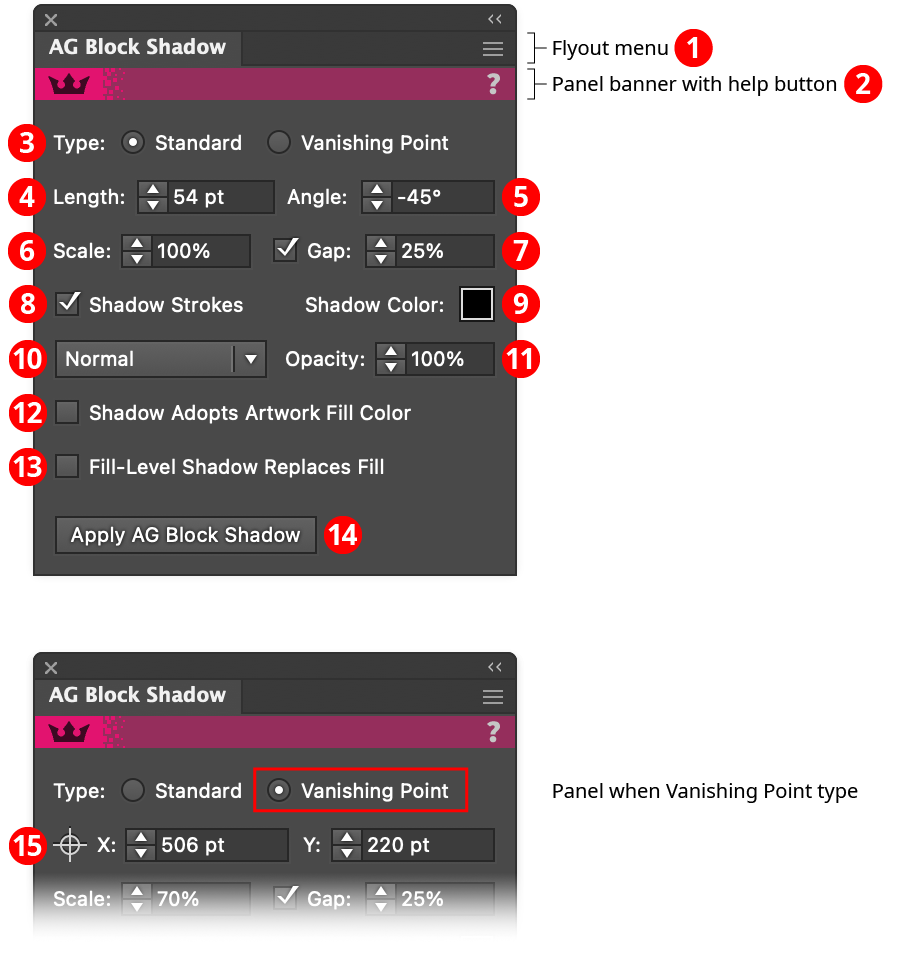
AG Block Shadow Panel
1. Flyout menu
See AG Block Shadow Panel: Flyout Menu.
2. Panel banner
The help button on the right opens the help documentation in the Astute Manager. If this does not automatically appear, please ensure your Astute Manager is running first.
3. Type
This control is only visible when the panel is in advanced mode (the panel flyout menu item Show Advanced Parameters has been chosen, or an AG Block Shadow effect using one of those advanced parameters is in the current selection). The radio buttons allow a choice between a Standard block shadow (specified by length and angle) and a Vanishing Point block shadow, which is specified through the coordinates of the vanishing point, the point to which the shadow appears to converge.
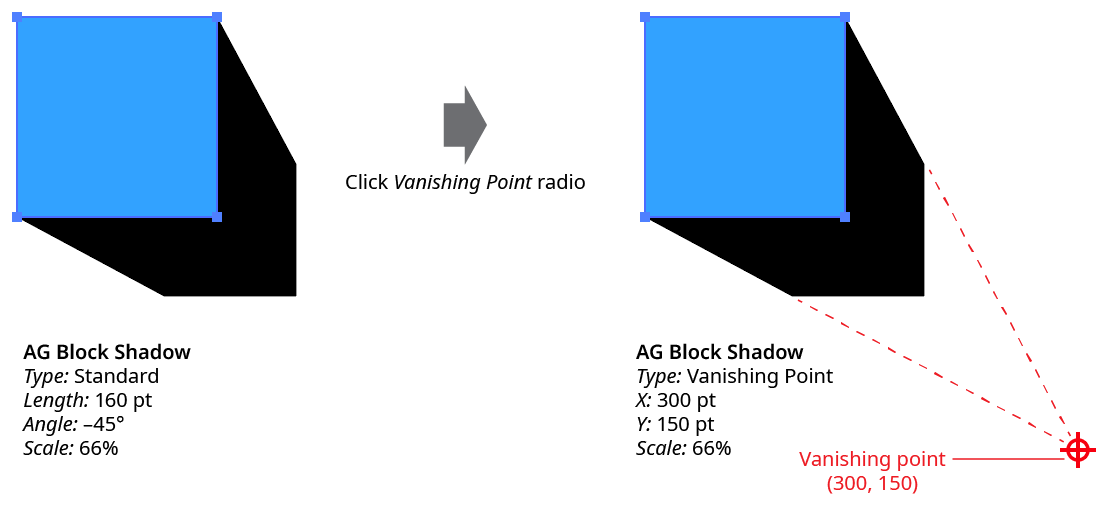
AG Block Shadow Type Example
Shadows can be freely converted between Standard and Vanishing Point, except when a Standard shadow has a Scale value of 100%, since this would imply a vanishing point at infinite distance. The advantage of a Vanishing Point type shadow is that the shadow’s point of convergence remains the same even if the object or objects to which the effect is applied are subsequently moved.

AG Block Shadow Standard vs. Vanishing Point
Tip: To move an object with a Vanishing Point type shadow and also move its vanishing point, convert the shadow to Standard type, move the object, and then convert back to Vanishing Point.
4. Length
For Standard type shadows, the nominal length of the shadow (distance from the edge of the object to the edge of the shadow, in the direction of the shadow). The default value is 72 pt. The length parameter is equal to the actual shadow length only when the shadow has no gap and the scale is set to 100%. Otherwise, the actual length may vary.
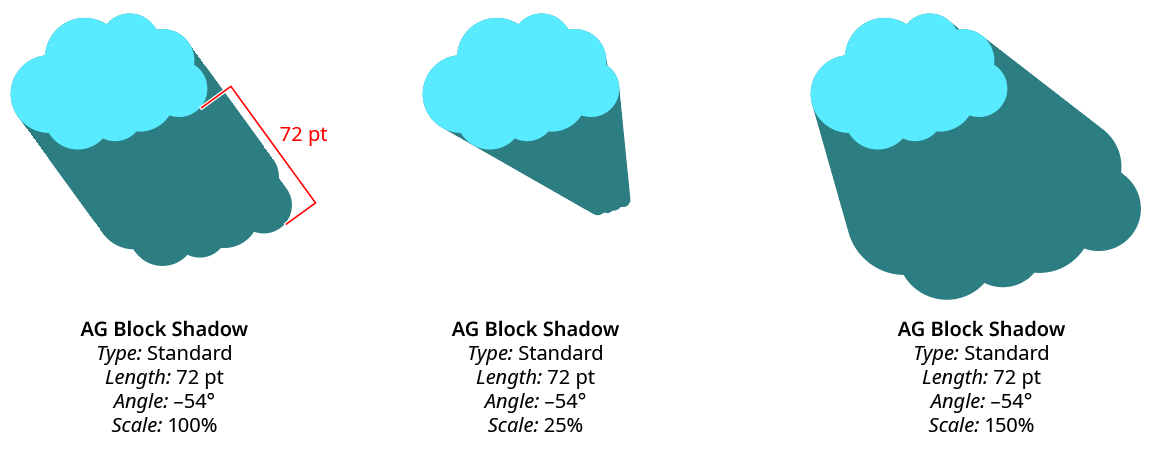
AG Block Shadow Length Comparison
5. Angle
For Standard type shadows, the angle of the shadow, specified using the normal Illustrator angle convention (to the right is 0°, with positive values going counterclockwise). The default value is –45°.
6. Scale
Specifies the relative size of the shifted shape that forms the end of the shadow, from 0% to 10000%. Scaling is done from the center of the shifted shape’s bounding box. Vanishing Point type shadows cannot have the default scale value of 100%, since this would imply a vanishing point located at infinite distance.
7. Gap
When enabled, a gap is left between the source object and its shadow. The size of the gap is specified as a percentage, which is relative to the length of the entire shadow.

AG Block Shadow Gap Examples
8. Shadow Strokes
When enabled, shadows are cast using not only object’s stroke, but also its fill.

AG Block Shadow Strokes
If the stroke is dashed, shadows will be cast from each dash, as expected (but the final shadow will still be united into a single path or compound path). If a path has a stroke but no fill, then when Shadow Strokes is enabled, the shadow will be produced only from the stroke.
9. Shadow Color
The color of the shadow, unless Shadow Adopts Artwork Fill Color is enabled. Clicking the color chip will bring up the standard color picker dialog. To fill a shadow with a gradient or pattern, see the parameter Shadow Adopts Artwork Fill Color. The default Shadow Color is black.
10. Blending Mode
Specifies the blending mode of the shadow, from among the standard sixteen Illustrator blending modes. The default is Normal blending mode.
11. Opacity
Specifies the opacity of the shadow (100%, by default).
12. Shadow Adopts Artwork Fill Color
When enabled, the shadow’s color will be taken from the fill of the artwork, including gradients and patterns. If there are multiple fills, then the first one in the Appearance stacking order is used (unless the live effect is placed inside a fill, in which case that fill is used). When applied to text with differently-colored glyphs, the color of the last glyph is used. If the object has no fill, then the color is taken from the Color parameter, just as if Shadow Adopts Artwork Fill Color were not enabled.
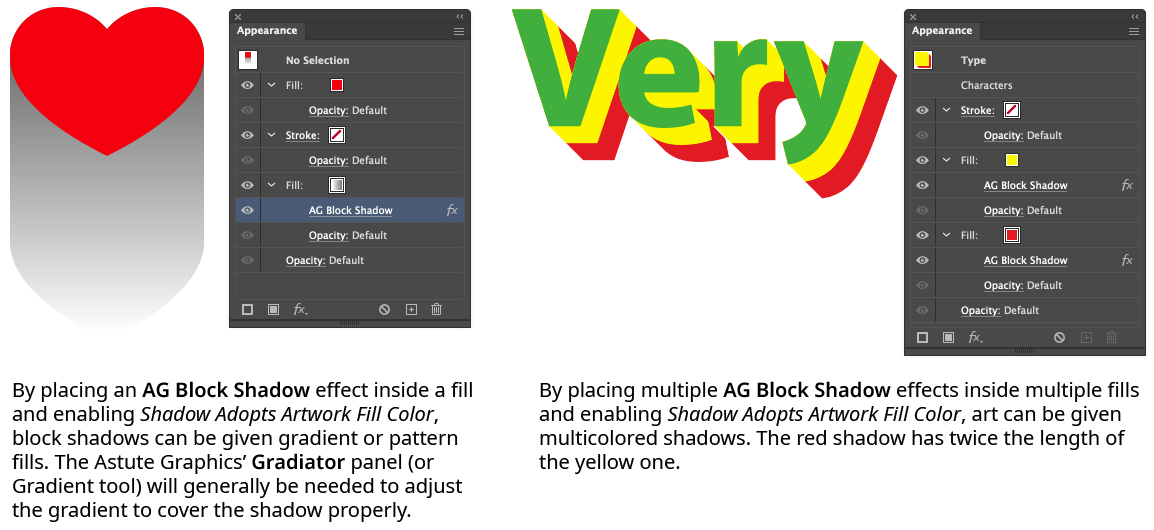
AG Block Shadow Adopt Fill Color
13. Fill-Level Shadow Replaces Fill
This control is only visible when the panel is in advanced mode (the panel flyout menu item Show Advanced Parameters has been chosen, or an AG Block Shadow effect using one of those advanced parameters is in the current selection). When enabled, and an AG Block Shadow effect has been put inside a fill in the Appearance panel, the fill from which the shadow is created is itself suppressed in the appearance. This is generally desirable unless using a block shadow with a gap because the shadow itself will also include the fill area, and an extra copy could cause undesirable results when combined with other live effects such as Boolean operations or blurs.
14. Apply Button
Click to apply the AG Block Shadow live effect to the selected artwork, with the parameters set as they currently exist in the panel. If the button is not available, then either nothing is selected or the selection already contains at least one object with an AG Block Shadow effect. If the button is clicked with Shift pressed, the shadow will be added and immediately detached, essentially creating it as editable artwork rather than as a live effect. However, this loses the ability to preview the effect first.
AG Block Shadow Panel Flyout Menu
The AG Block Shadow panel flyout menu items are contextually sensitive and all items may not be available, depending on the current selection.
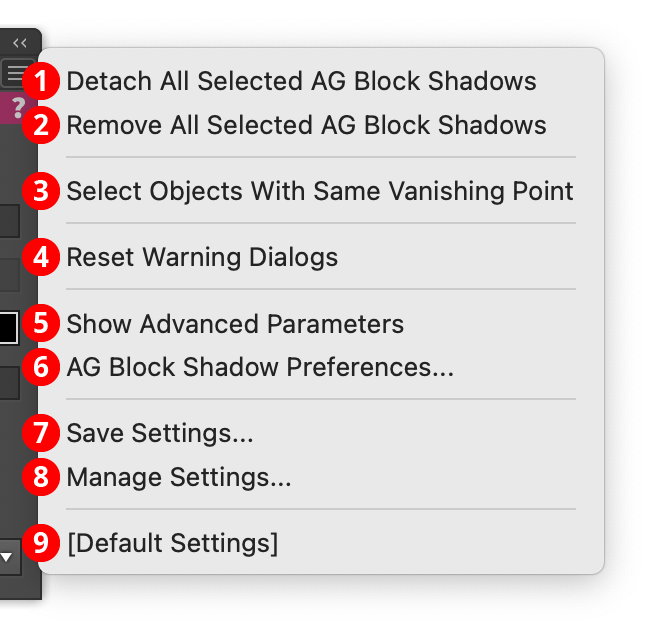
AG Block Shadow Panel Flyout Menu
1. Detach All Selected AG Block Shadows
Changes the shadows created by all AG Block Shadow live effects in the selection into editable artwork, and removes the effect from the appearance(s). This is similar to using the native menu command Object > Expand Appearance, but is more flexible because it leaves the existing artwork (and other live effects which may be present) intact.
2. Remove All Selected AG Block Shadows
Removes any AG Block Shadow live effects from the selection. (This can be done from the Appearance panel as well, but not if multiple AG Block Shadow effects are present with different parameters. In that case, the Appearance panel will simply display “Mixed Appearances” and the ability to select the live effect and delete it will no longer be available.)
3. Select Objects With Same Vanishing Point
Available if a single art object with a Vanishing Point type AG Block Shadow is selected. The menu item will select all other objects with an AG Block Shadow effect that has the same vanishing point coordinates. Different coordinates may then be entered on the panel, moving the vanishing point of all the objects together (this can also be done with the AG Block Shadow tool).
4. Reset Warning Dialogs
If one or more of AG Block Shadow’s warning dialogs (for example, the one shown when trying to use the AG Block Shadow tool in Pattern Editing Mode) have been suppressed using the Don’t show again checkbox, clicking this button will re-enable them.
5. Show Advanced Parameters
The Standard/Vanishing Point type controls and the Fill-Level Shadow Replaces Fill checkbox control are considered advanced parameters, and can be shown or hidden on the panel using this menu item. When the controls are visible, the menu item will change to Hide Advanced Parameters. If one or more objects in the current selection containing an AG Block Shadow effect that is Vanishing Point type or has Fill-Level Shadow Replaces Fill enabled, the advanced controls will automatically be shown so that the effect(s) can be properly edited.
6. AG Block Shadow Preferences...
Brings up the preference dialog (see AG Block Shadow: Preferences).
7. Save Settings...
Captures all of the current parameter settings on the panel to a file, which can be instantly recalled later (either in the current file session or a later one). A dialog will appear through which the file name may be specified.
8. Manage Settings...
Brings up a dialog through which existing settings files may be renamed or deleted:

AG Block Shadow Manage Settings Dialog
A. Settings List: Shows all user-saved settings. One or more settings files can be selected for use with the buttons at the bottom of the dialog by clicking on them in the list, with Shift pressed to select contiguously or Command/Ctrl pressed to select discontiguously, as normal.
B. Rename Button: If a single settings file is selected, allows it to be renamed, through a separate dialog. If the Cancel button is used, the original names will be restored.
C. Delete Button: Removes the selected settings file(s). The files are not permanently deleted until the OK button is clicked.
9. Settings Files
User-defined settings will appear below the built-in [Default Settings] menu item. Choosing a settings menu item will load the panel with the settings it had when the file was saved; the AG Block Shadow effects in any selected art will be updated to match.
